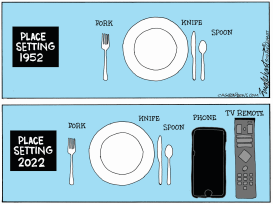
Dear Ms Smartphone: The cartoon you had on Instagram this week got me thinking. It shows a place setting from the 1950’s with a plate, a knife, and a fork. Next to it is a contemporary place setting with a plate, a knife, a fork, also a TV clicker and mobile phone. Here’s my question: If you had to choose, would it be a phone at the dinner table or a TV remote? Lee, Silver Spring.
Dear Lee: First, recognition to the syndicated artist. His name is Bob Englehart and his online bio says that he was born in 1945 in Indiana. That tells us that he is a Boomer and has personally experienced the progression of the place settings. *
As to whether I would choose the phone or the TV remote, my first response is neither, but there will be exceptions! Reacting to the cartoon on Instagram, one follower notes that he does food photography so no meal is left unphotographed! Short of that, we devalue our food and the people who prepared it when we let electronics intercede. There’s considerable research that shows the quality of conversation between two people suffers when one of them puts a phone on the table, even if the phone is turned off. The presence of the phone takes people out of the immediate moment.
Electronic media, whether TV or phone, moves our awareness away from the meal being served, i.e., the present moment. Alternatively, you could use mealtime as a go-to exercise in mindfulness. And, the best thing is that you get to practice it three times a day. To begin, you acknowledge and give thanks for the water and soil and sun, the farmers, the harvest, and the workers in the supply chain that help bring this food to your plate.
When we eat in front of the TV or distract ourselves with our phone we are less mindful- we may forget to pay attention to the flavor of the food, how much has been eaten, and occasionally, whether we are satiated. There is a strong correlation (not causality) between spending more time on TV and obesity. For teens, more hours on video games and electronic media is associated with obesity. Most likely, there is a trigger-cue-behavior of engaging with media, distraction, and snacking. If we start doing this at the dinner table, does that habit follow us to the family room and other spaces where we use electronic devices?
But, back to the question you raised. I would choose the TV over the phone at the dinner table. TV is less of a one-to-one medium than the smartphone. I personally have the day’s newspapers spread out at breakfast and lunch. Sometimes the TV show or newspapers will draw out a conversation, and create a more shared experience. Mealtime should be an opportunity for families to reconnect, even if their conversation focusses on the cartoon! The presence of a phone implicitly says that a family member prioritizes something outside the room over the people who are present.
It’s been a while since I watched much over-the-air TV, but prime-time used to be filled with ads for snacks, sugar filled drinks, and higher fat foods. Today, these have been supplanted by ads for prescription drugs and pills. Is one healthier than the other? It might be a good idea if you do watch family TV together to draw attention to the content of these ads and talk through what screen-time is telling us about ourselves. If you follow the ads on your smartphone, they will be more personalized based on what you scroll for and spend time looking at. What content are they pushing? That might be a great discussion to have over the dinner table!
* Englehart’s toon ran on the editorial pages of the Bay Area Newspaper Group (Marin Independent) on 3/8/22).

Leave a Reply
You must be logged in to post a comment.